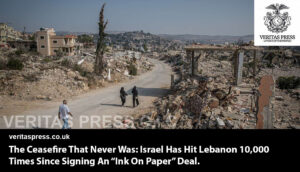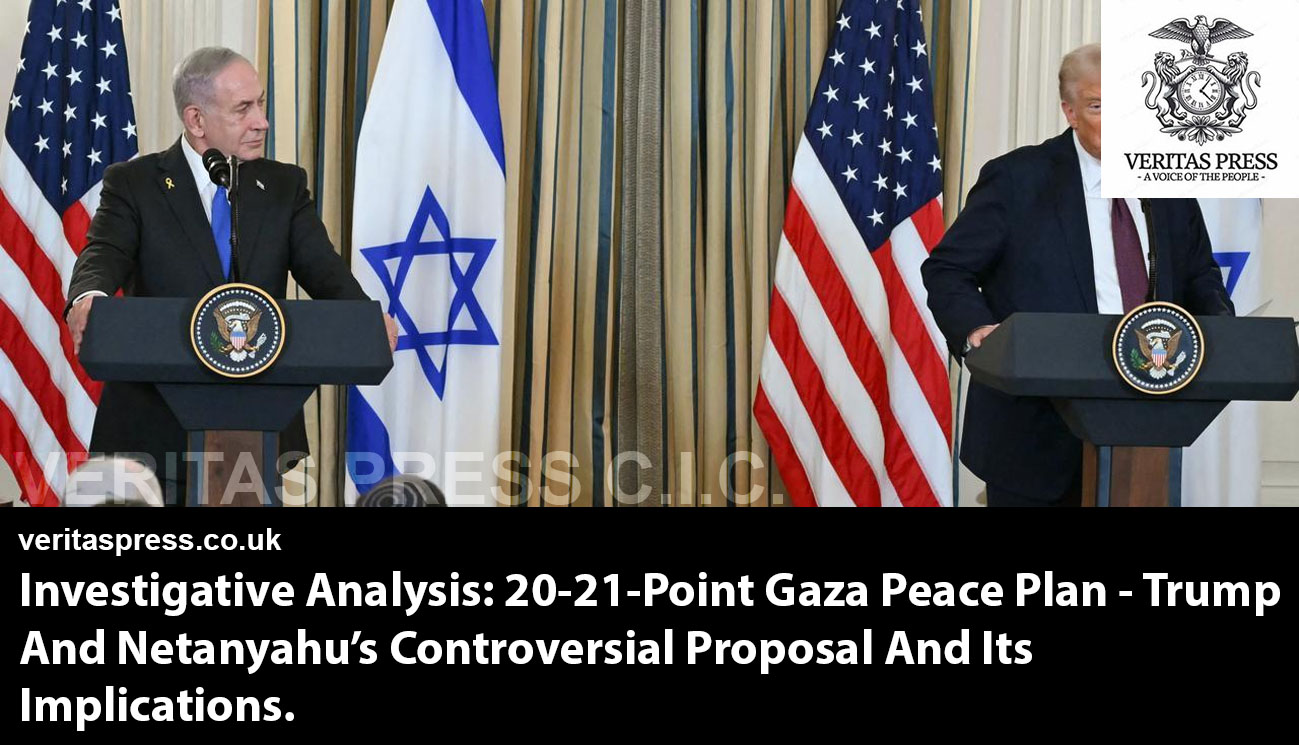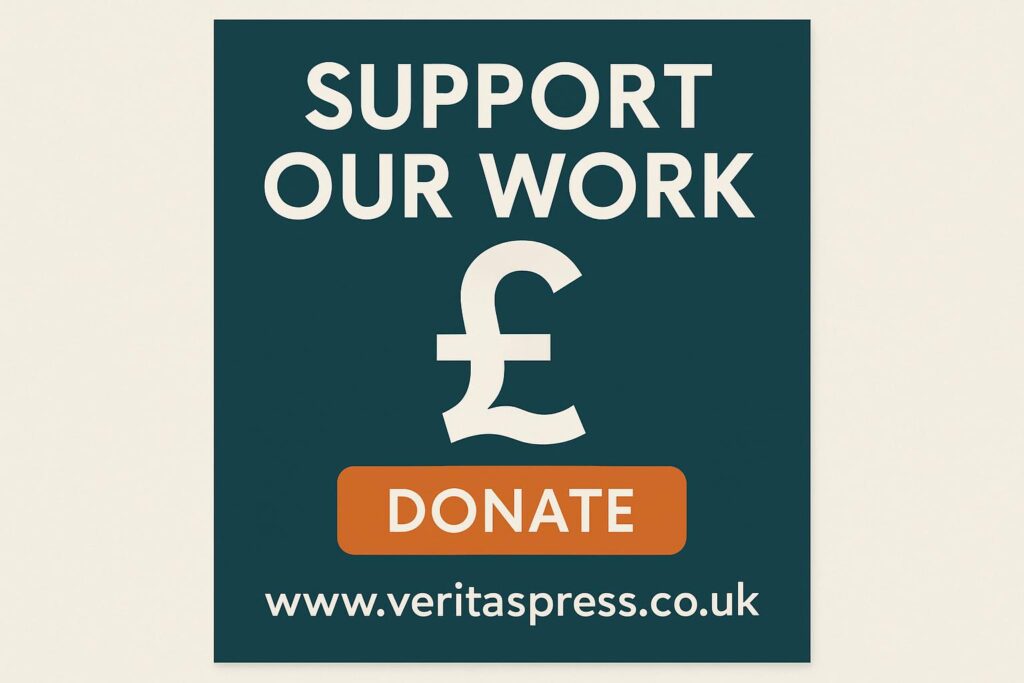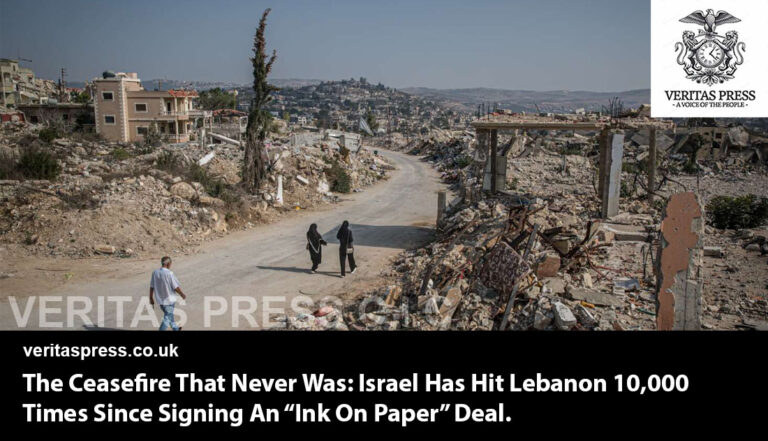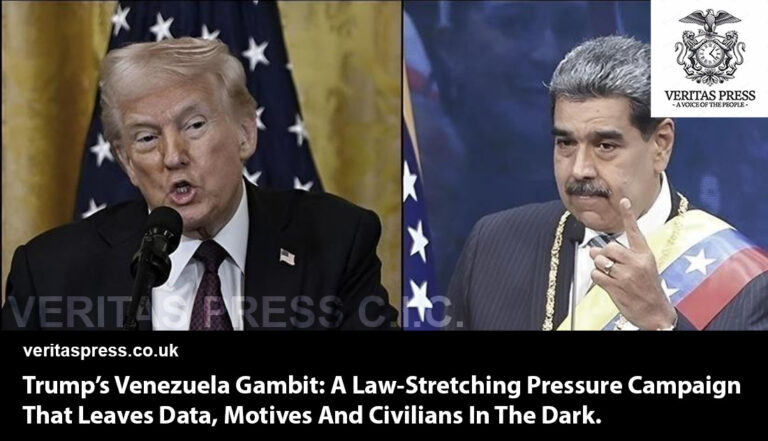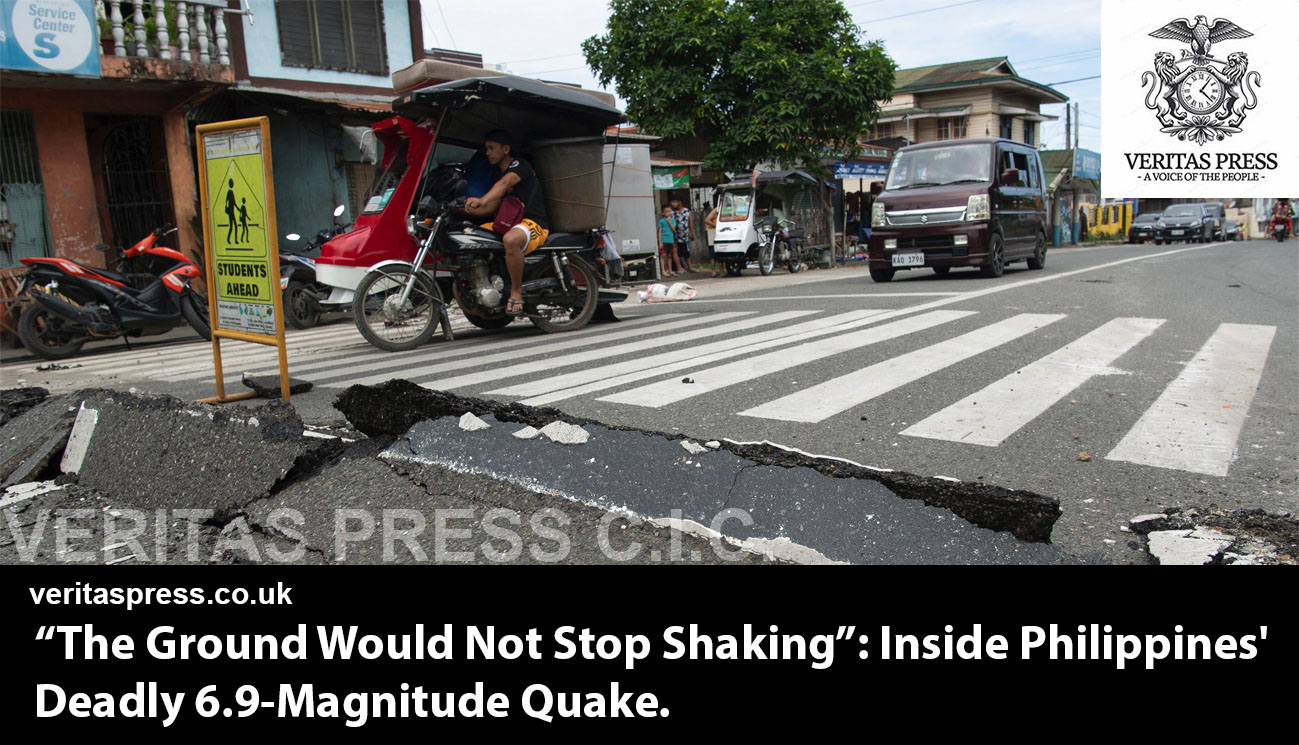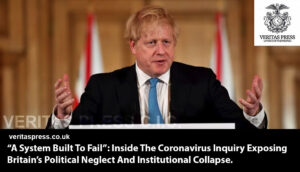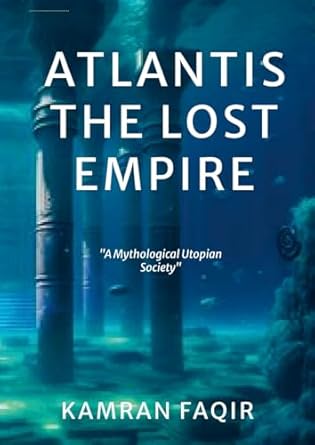USA-ISRAEL – On September 29, 2025, U.S. President Donald Trump and Israeli Prime Minister Benjamin Netanyahu unveiled a sweeping 20-21 point peace plan aimed at ending Israel’s war on Gaza. Described by Trump as “a plan like no other, a plan that will finally bring peace to Gaza,” the proposal has been framed as a historic breakthrough to resolve the conflict that has devastated the Palestinian territory for months.
Speaking at a joint White House press conference, Trump declared:
“No more endless wars, no more excuses, peace is coming to Gaza. This plan will ensure the people of Gaza are free from terror and can finally rebuild their lives.”
Netanyahu echoed support for the plan but issued firm caveats:
“I support your plan to end the war in Gaza, which achieves our war aims. It will bring back to Israel all our hostages, dismantle Hamas’ military capabilities, end its political rule, and ensure that Gaza never again poses a threat to Israel.”
Yet, the plan has already exposed significant divergences between the U.S. vision and Israeli policy, particularly on long-term governance and security arrangements in Gaza.
Trump’s Vision: The 20-21-Point Peace Plan.
The plan sets out detailed steps for ending hostilities, demilitarising Gaza, and establishing a transitional governance and reconstruction framework. Highlights include:
- Immediate Ceasefire: Halt all military operations by both Israeli and Hamas forces.
- Hostage Exchange: Release all Israeli hostages in exchange for Palestinian prisoners held in Israeli jails.
- Hamas Disarmament: Complete dismantling of Hamas’ military infrastructure and armed wing.
- International Governance: Transitional administration led by a board including Trump and former UK Prime Minister Tony Blair.
- Economic Reconstruction: U.S.-led initiatives to rebuild Gaza’s infrastructure and economy.
- Security Arrangements: Deployment of an international stabilisation force (ISF) to maintain order and assist the transition.
- Amnesty Provisions: Grant amnesty to Hamas members who commit to peaceful coexistence or leave Gaza.
- Palestinian Authority Reforms: Implement reforms to ensure effective governance and prevent future conflicts.
- Humanitarian Aid: Unrestricted access for international aid organisations.
- Civilian Protection: Establish safe zones to protect civilians during transition.
- Border Control: Regulate crossings to prevent weapon smuggling and militant infiltration.
- Media Restrictions: Limit incitement and misinformation in public messaging.
- Education Initiatives: Promote peace education and youth programs.
- Cultural Exchange: Encourage programs fostering Israeli-Palestinian understanding.
- Legal Reforms: Create frameworks addressing past grievances and justice claims.
- Property Rights: Protect property ownership for Gaza residents.
- Environmental Protection: Implement sustainable development initiatives.
- Public Health: Rebuild healthcare infrastructure and expand services.
- Employment Programs: Create jobs and reduce poverty.
- International Support: Mobilise regional and global backing for reconstruction and security.
- U.S.-Led Israeli-Palestinian Dialogue: Establish a dialogue between Israel and the Palestinians to define a political horizon for peaceful coexistence.
Trump emphasised the plan’s collaborative approach:
“We are relying on countries in the region to help implement this plan. Arab and Muslim nations will be key partners in stabilising Gaza, decommissioning terror groups, and helping train local Palestinian police forces. Hamas must understand this is a different scenario than before, their leadership has been decimated, and they face a choice: cooperate or be held accountable.”
Netanyahu’s Position: Security First.
While Netanyahu publicly endorsed the plan, he immediately clarified Israel’s interpretation:
“Israel will retain security responsibility, including a security perimeter, for the foreseeable future. Gaza will have a peaceful civilian administration, run neither by Hamas nor the Palestinian Authority, but by those committed to a genuine peace with Israel.”
On potential noncompliance by Hamas, he issued a stark warning:
“This could be done the easy way, or it could be done the hard way. But it will be done. Israel will finish the job if Hamas rejects the plan or attempts to undermine it.”
Netanyahu also flagged his reservations regarding the U.S.-proposed pathway to Palestinian self-determination, a point long opposed by his government:
“Giving the Palestinians a state one mile from Jerusalem after October 7th is like giving Al-Qaeda a state one mile from New York City after September 11th. This is sheer madness. We will not allow a terror state near our capital.”
Key Points Of Contention:
Hamas’ Response:
Hamas has yet to accept the plan. Analysts warn that the proposal’s requirement for full disarmament and surrender of operational control will be seen as a near-total capitulation. Al Jazeera analyst Marwan Bishara described the plan as “essentially an ultimatum to surrender, or face intensified Israeli military action.”
Hamas negotiators, informed through Qatar and Egypt, are reviewing the plan but remain sceptical, citing the indefinite timeline for Palestinian Authority reforms and the vague guarantees for Gaza’s autonomy.
Palestinian Authority and Statehood:
The plan envisions eventual governance by the Palestinian Authority only after reforms are implemented and Gaza’s redevelopment is advanced. For Netanyahu, this is a loophole: the PA may never assume real control, aligning with Israel’s long-standing rejection of a Palestinian state.
“The plan says there should be a credible pathway to Palestinian statehood, but that’s something Netanyahu has fought against his entire political career,” noted Al Jazeera correspondent James Bays.
Implementation Challenges:
Experts highlight several practical obstacles:
- Trust Deficit: Both sides have deep mistrust. Past ceasefires collapsed within months.
- Asymmetry: Hamas faces total disarmament and surrender, while Israel retains operational security.
- Unclear Timelines: ISF composition, PA reforms, and civil administration remain undefined.
- West Bank Exclusion: The plan focuses on Gaza and does not address West Bank settlements or clashes.
- Internal Israeli Politics: Hardline coalition members, including Bezalel Smotrich and Itamar Ben-Gvir, demand total destruction of Hamas and may resist compromises.
Analysis And Outlook:
The 21-point peace plan, while comprehensive, hinges on cooperation from parties historically at odds.
Trump’s rhetoric underscores U.S. commitment:
“We want peace. We want prosperity. We want the people of Gaza to have a future free from terror. This is a moment to make history, to end the bloodshed.”
Netanyahu, by contrast, signals caution: Israel will maintain a security-first approach and retain contingency plans to act unilaterally if Hamas fails to comply.
Hamas’ next moves will determine whether the plan can achieve even a temporary cessation of hostilities. Meanwhile, the international community, particularly Qatar, Egypt, and other Arab states, is tasked with mediating compliance and supporting reconstruction efforts.
Comparative Analysis: Trump’s 20-21-Point Plan Vs. Historical Peace Efforts.
1. Governance and Political Horizon
- Trump’s Plan: Proposes a U.S.-led dialogue between Israel and Palestinians to define a political horizon for peaceful coexistence.
- Historical Context: Previous plans, such as the Oslo Accords, aimed for Palestinian self-rule but faced challenges due to disagreements on final status issues like Jerusalem and refugees.
2. Demilitarisation and Security Arrangements
- Trump’s Plan: Calls for the dismantling of Hamas’ military infrastructure and the establishment of an International Stabilisation Force (ISF).
- Historical Context: The Oslo Accords envisioned a phased Israeli withdrawal and Palestinian security responsibilities, but implementation was hindered by mutual distrust and violence.
3. Humanitarian Aid and Reconstruction
- Trump’s Plan: Includes provisions for large-scale international aid and infrastructure redevelopment, with a special economic zone for Gaza.
- Historical Context: Past efforts have seen limited success in reconstruction due to ongoing conflicts and restrictions.
4. Hostage and Prisoner Exchange
- Trump’s Plan: Mandates the return of all Israeli hostages and the release of Palestinian prisoners within 72 hours.
- Historical Context: While exchanges have occurred, they often serve as temporary measures without leading to lasting peace.
5. Pathway to Palestinian Statehood
- Trump’s Plan: Suggests a potential route to Palestinian statehood through renewed U.S.-mediated dialogue.
- Historical Context: Previous initiatives, like the Clinton Parameters, proposed a two-state solution but faced obstacles such as Israeli settlement expansion and Palestinian political divisions.
Key Observations:
- Asymmetry in Power Dynamics: The plan heavily favours Israeli security concerns, potentially sidelining Palestinian aspirations for sovereignty.
- Implementation Challenges: The effectiveness of the proposed ISF and the feasibility of disarming Hamas remain uncertain.
- International Support: While some Arab nations have shown cautious endorsement, the plan’s acceptance hinges on Hamas’ agreement and broader Palestinian support.
Summary Table: Comparative Overview.
| Aspect | Trump’s 21-Point Plan | Oslo Accords (1993) |
| Governance | U.S.-led dialogue for peaceful coexistence | Palestinian self-rule with limited autonomy |
| Demilitarisation | Dismantling of Hamas’ military infrastructure | Phased Israeli withdrawal and Palestinian security responsibilities |
| Humanitarian Aid | Large-scale international aid and reconstruction | Limited aid due to ongoing conflicts |
| Hostage Exchange | Return of hostages and release of prisoners | Occasional exchanges without lasting peace |
| Pathway to Statehood | Potential route through U.S.-mediated dialogue | The proposed two-state solution is hindered by obstacles |
Conclusion — From Conditional Peace To Conditional Dispossession: The Real Risk In The 20-21 Point Gaza Peace Plan.
The Trump–Netanyahu 20-21-point plan is presented as a sweeping corrective to two years of war: an end to hostilities, the return of hostages, demilitarisation of Hamas, technocratic governance, and a headline economic redevelopment programme. Yet its core architecture, heavy on conditionality, light on enforceable protections, and built on an asymmetry of power, creates precisely the opening that critics warned about before the plan was formally announced: the risk that reconstruction becomes a vehicle for displacement rather than restitution.
Human-rights organisations, UN experts and investigative journalists have repeatedly flagged that elements of the plan mirror earlier proposals and leaked prospectuses, the so-called “Riviera” or “Riviera‑style” redevelopment schemes, that envisioned large-scale relocation, conditional returns, and investor-led urban remakes of Gaza. Those proposals did not include ironclad legal guarantees of return or durable protections for property and civil status; rights groups warned then that incentives or coercion framed as “voluntary relocation” would, in practice, amount to forced displacement. The current 20-21‑point architecture reproduces the same fault lines: promises about “no forced transfer” are not backed by clear legal mechanisms, and reconstruction control is concentrated in an international board with broad discretion.
A second, more immediate danger is operational: what happens to those who do not or cannot leave. Multiple reports. Including Israeli planning for postwar Gaza and media investigations into proposed “humanitarian cities”, have raised alarms that authorities have considered concentrating remaining Palestinians into heavily controlled camps or encampments under military oversight. Human Rights Watch, the UN’s human‑rights office, and major outlets have warned that plans for segregated, militarised “humanitarian” zones can become permanent instruments of internment and loss of civil rights unless they are explicitly outlawed and replaced with rights-based alternatives. The 20-21‑point text leaves the mechanisms for accommodation and freedom of movement vague; consequently, analysts say there is a credible risk that encampment schemes, coupled with long delays or conditional returns, would strip displaced Gazans of basic legal protections tied to residence and property.
Third, the security asymmetry is decisive. Netanyahu’s insistence that Israel will “retain security responsibility, including a security perimeter, for the foreseeable future,” combined with the plan’s reliance on an International Stabilisation Force whose composition, legal mandate and accountability remain undefined, hands Israel the practical means to shape who can return, when, and under what rights. In contexts where military authorities control territory and humanitarian access, legal declarations against forced transfer are insufficient without binding international guarantees, independent monitoring, and judicial remedies.
If the plan proceeds without the five safeguards human‑rights groups and regional mediators have recommended, binding legal guarantees of no forced transfer and the right of return, an ISF under UN mandate with clear jurisdiction and oversight, an empowered and locally legitimate Palestinian role in governance from the start, independent monitoring of reconstruction and land claims, and parallel measures addressing the West Bank, the result is unlikely to be durable peace. Instead, the likely sequence is temporary ceasefires followed by structural displacement: many Gazans pressured or incentivised to leave permanently, and those who remain confined to militarised encampments with curtailed civil rights. That outcome would amount to a de‑facto reconfiguration of Gaza’s demography and legal order under the guise of redevelopment.
The 20-21-point document, therefore, reads less as a final settlement than as a conditional blueprint, promising reconstruction and a political horizon only if actors comply with asymmetrical sequencing that leaves Palestinians with little leverage and few legal protections. Whether the world will permit such a transformation depends on the immediate insertion of enforceable safeguards and real international accountability. Without them, the plan risks codifying a new era of dispossession: the “Riviera” not as recovery but as a cover for demographic engineering, and encampment not as temporary shelter but as permanent removal from rights, land and memory.
Phyllis Bennis, a fellow at the Washington-based Institute for Policy Studies, warned bluntly that “there are no guarantees here to protect Palestinian interests.” Her critique encapsulates the core problem: the plan envisions a post-war Gaza in which Palestinians are dependent on external oversight, with little recourse to enforce their rights.
Several Red Flags Stand Out:
- Asymmetric Power Dynamics: Israel retains long-term security control, including a permanent security perimeter. Gaza’s civilian administration is subordinated to a U.S.-led “Board of Peace,” chaired by Trump and including international technocrats, effectively sidelining Palestinian political institutions and civil society.
- Conditional Statehood and Political Marginalisation: Palestinian statehood is deferred, contingent on reforms in the Palestinian Authority and the successful redevelopment of Gaza. Until such conditions are met, Palestinians have no sovereign authority over their territory.
- Forced Displacement Risks: While the plan publicly encourages Gazans to remain, reports suggest it is a disguised mechanism to facilitate mass migration. Those who leave risk being permanently stripped of legal rights, while those who remain may face confinement in encampments under military oversight.
- Economic Restructuring as Control: The proposed U.S.-led economic development plan, convening experts who have helped build “miracle cities” in the Middle East, masks what critics describe as a Rivera-style blueprint for controlled redevelopment. Reconstruction may come at the cost of Palestinian self-determination, tying aid and infrastructure directly to compliance with political and security conditions dictated externally.
- Implementation Gaps: Critical aspects of the plan, including the International Stabilisation Force, policing arrangements, and the Board of Peace’s authority, lack specificity. Historical precedent demonstrates that vague enforcement mechanisms and asymmetric agreements frequently fail, leaving populations vulnerable to renewed cycles of violence.
- Hamas’ Acceptance: The plan’s success hinges on Hamas’ agreement to disarm and participate indirectly in governance. Given the ultimatum-style framing, this may be politically unpalatable, creating a high risk of either rejection or partial compliance, which could provide Israel pretext for renewed military operations.
Taken together, these factors suggest that the 20-21-point plan, while framed as a “historic moment for peace,” is heavily tilted toward Israel, offering Palestinians conditional aid and oversight rather than genuine sovereignty. The promise of economic revival and statehood, without enforceable guarantees, may serve as a tool for continued control and, potentially, displacement.
The coming weeks will be critical. International mediators, regional actors, and civil society will need to apply sustained pressure to ensure the plan does not become yet another episode in the long history of broken promises in Gaza. Without enforceable protections for Palestinian interests, the plan risks perpetuating the cycle of conflict it purports to end, turning reconstruction and diplomacy into instruments of control rather than genuine peace.
Sourced Annexe: Mapping Displacement Risks in the Trump–Netanyahu 20-21-Point Gaza Peace Plan.
1. Ceasefire Implementation
- Risk: While the plan proposes an immediate ceasefire, the absence of clear enforcement mechanisms raises concerns about the potential for continued hostilities and instability.
2. Hostage and Prisoner Exchange
- Risk: The plan’s focus on hostage and prisoner exchanges may divert attention from broader humanitarian issues, potentially sidelining the rights and needs of the wider Palestinian population.
3. Amnesty for Compliant Hamas Members
- Risk: The provision of amnesty to Hamas members who comply with the plan could be perceived as legitimising a specific political faction, potentially undermining efforts for inclusive governance.
4. Demilitarisation of Gaza
- Risk: The plan’s emphasis on demilitarisation may be interpreted as an effort to suppress Palestinian resistance, leading to increased tensions and potential unrest.
5. International Stabilisation Force (ISF) Deployment
- Risk: The establishment of an ISF without clear mandates and accountability mechanisms could lead to perceptions of foreign occupation, exacerbating local grievances.
6. Temporary Technocratic Governance
- Risk: The introduction of a technocratic governance model may lack democratic legitimacy, potentially alienating the Palestinian populace and hindering effective governance.
7. Exclusion of Hamas from Future Governance
- Risk: The exclusion of Hamas from future governance structures could lead to political fragmentation and undermine efforts for national reconciliation.
8. Conditional Pathway to Palestinian Statehood
- Risk: The conditional nature of the proposed pathway to statehood may prolong the denial of Palestinian self-determination and sovereignty.
9. Economic Reconstruction and Special Economic Zones
- Risk: The focus on economic reconstruction without addressing underlying political issues may lead to economic dependency and exacerbate social inequalities.
10. Encouragement for Palestinians to Remain in Gaza
- Risk: While encouraging Palestinians to remain in Gaza, the plan lacks guarantees for their safety and rights, potentially leading to coerced settlement in militarised zones.
11. Establishment of a Special Economic Zone
- Risk: The creation of a special economic zone may prioritise foreign investment over local needs, leading to displacement and loss of livelihoods for Palestinians.
12. No Forced Displacement Clause
- Risk: Despite the clause stating no forced displacement, the lack of enforcement mechanisms raises concerns about the potential for indirect coercion and displacement.
13. Encouragement for Palestinians to Stay in Gaza
- Risk: Encouraging Palestinians to stay without providing adequate protection may lead to their entrapment in conflict zones, increasing vulnerability.
14. International Oversight of Reconstruction
- Risk: International oversight without local participation may lead to reconstruction efforts that do not align with the needs and desires of the Palestinian population.
15. Conditional Return for Displaced Palestinians
- Risk: The conditional return for displaced Palestinians may result in prolonged displacement and uncertainty about their future.
16. Regional Security Guarantees
- Risk: Regional security guarantees may prioritise state security over human rights, leading to the suppression of Palestinian civil liberties.
17. Israeli Withdrawal as Stability Improves
- Risk: The phased Israeli withdrawal may be used as leverage, delaying Palestinian sovereignty and self-determination.
18. No Annexation of Gaza
- Risk: While the plan opposes annexation, the establishment of a transitional governance structure may lead to de facto control without Palestinian consent.
19. International Stabilisation Force’s Role
- Risk: The role of the International Stabilisation Force may be perceived as foreign occupation, leading to resistance and potential unrest.
20. Palestinian Authority’s Role Post-Reforms
- Risk: The Palestinian Authority’s role post-reforms may be limited, undermining efforts for democratic governance and self-determination.
21. U.S.-Facilitated Dialogue for Peaceful Coexistence
- Risk: U.S.-facilitated dialogue may prioritise Israeli interests, sidelining Palestinian aspirations and rights.


